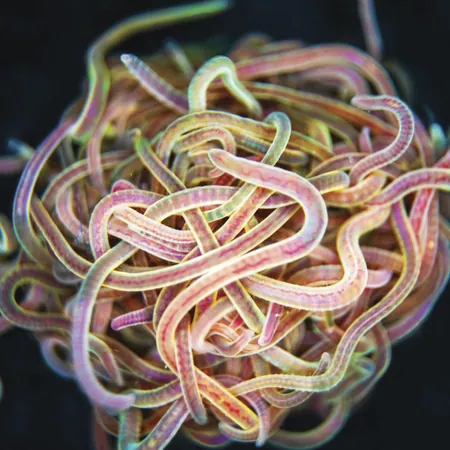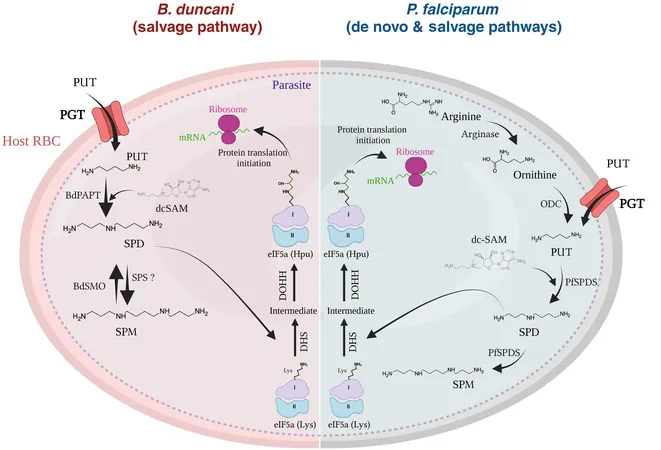
Unlocking the Secrets of Living Worm Clusters: The Surprising Behavior of Active Polymers
2025-06-16
Author: Ming
Worms and Jellyfish: Nature's Tangle
Have you ever stumbled upon a wriggling mass of earthworms? These slippery creatures form such intricate clusters that breaking free can feel nearly impossible. Surprisingly, a similar phenomenon occurs in nature with the tentacles of lion’s mane jellyfish entangled in the currents of the ocean. But that’s not just a quirky fact; this behavior is now inspiring the next generation of robotic grippers, using multiple synthetic arms mimicking these natural structures to grip and move objects with dexterity.
What Are Polymer Chains?
In scientific terms, these wriggling chains are known as polymer chains. When isolated from external forces, the movement and dynamics of these tangled chains can be described using traditional polymer physics. Imagine them slithering along a complicated tube created by their neighbors—this model helps predict how these chains manage to escape entanglements.
A Breakthrough Discovery
Professor Dr. Hartmut Löwen from the Institute for Theoretical Physics II at Heinrich Heine University (HHU) reveals that physicists have long used a 'scaling law' to determine how quickly a chain can escape a cluster based on its length. Think of it as a timeline: the longer the chain, the longer it takes to break free. This theory, awarded the Nobel Prize to Pierre-Gilles de Gennes in 1991, has served as a cornerstone for understanding polymer dynamics.
The Mystery of Active Polymers
But what happens when the polymers are active? For instance, when they consist of writhing living worms? This key question in the field of "active soft matter" remained elusive—until now.
Revolutionary Research Findings
A collaborative effort between researchers at HHU, the Technical University of Darmstadt, Dresden University of Technology, and the Max Planck Institute for the Physics of Complex Systems led to groundbreaking discoveries. Published in *Nature Communications*, their large-scale computer simulations revealed that the rules governing these active polymers differ drastically from their passive counterparts.
New Insights into Polymer Dynamics
They discovered a new exponent that characterizes how these active polymers escape entanglements, coupled with a revised tube model that explains these phenomena. Dr. Davide Breoni, the lead author of the study, expressed the complexity of creating these polymer clusters in simulations but confirmed that they could derive essential scaling laws.
Surprising Implications for Physics
Dr. Suvendu Mandel, who contributed as a postdoc, states that these new discoveries could revolutionize polymer physics. Contrary to intuition, the active movement of living systems appears to make them more prone to entangle and block themselves, increasing rigidity rather than facilitating a swift escape.
Practical Applications on the Horizon
Professor Löwen emphasizes the practical applications of this research: "These findings could lead to the creation of innovative 'smart materials' that instantly become more rigid at the touch of a button, transforming their viscoelastic properties." The future surely looks exciting as we unveil the mysteries behind nature’s tangled wonders and their potential to inspire high-tech solutions in our everyday lives!

 Brasil (PT)
Brasil (PT)
 Canada (EN)
Canada (EN)
 Chile (ES)
Chile (ES)
 Česko (CS)
Česko (CS)
 대한민국 (KO)
대한민국 (KO)
 España (ES)
España (ES)
 France (FR)
France (FR)
 Hong Kong (EN)
Hong Kong (EN)
 Italia (IT)
Italia (IT)
 日本 (JA)
日本 (JA)
 Magyarország (HU)
Magyarország (HU)
 Norge (NO)
Norge (NO)
 Polska (PL)
Polska (PL)
 Schweiz (DE)
Schweiz (DE)
 Singapore (EN)
Singapore (EN)
 Sverige (SV)
Sverige (SV)
 Suomi (FI)
Suomi (FI)
 Türkiye (TR)
Türkiye (TR)
 الإمارات العربية المتحدة (AR)
الإمارات العربية المتحدة (AR)